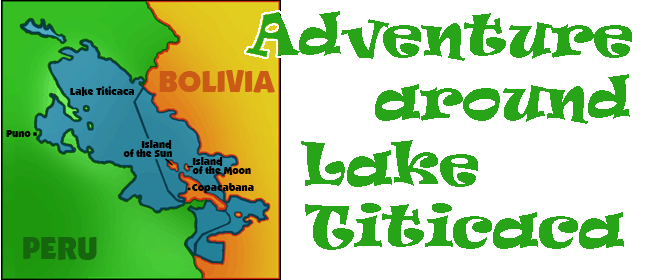Adventure around
Lake Titicaca
I was shocked when I arrived in
Cusco. On my first visit, it was a charming little town.
Most of the people who came to visit were backpackers on a budget.
There wasn't much set up for tourism. But, that was then and this
is now. Now, the city was huge! The central part of Cusco
was set up for the swarms of tourists from all over the world.
This was Peru's number one tourist attraction and they were ready.
There were souvenirs for sale all over town as well as internet cafes,
pizza, currency exchanges, and high end shopping stores. There was
even a Starbucks overlooking the center square with its beautiful
cathedral! I can't say that all change is good, but I can say that
change is inevitable. And that charming little hotel at Machu
Picchu where I paid $35 for a night now charged $1000 for a room!
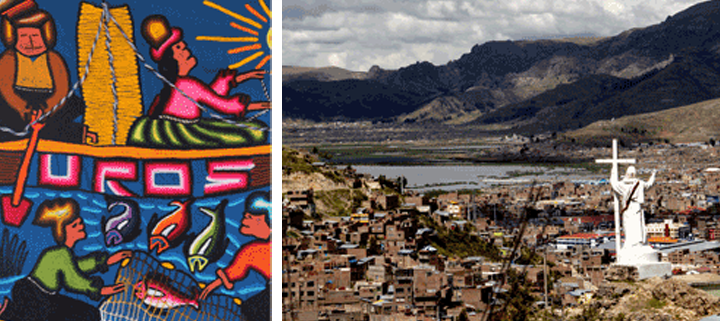

I left Cusco and headed south to Puno on
Lake Titicaca. You go to Puno to see the floating islands of the
Uros Indians. The last time I was there, there were no other
tourists. People stared at me on the street. But, I found my
way around easily. The town was so tiny that it wasn't
hard. I hired a triciclo, a tricycle taxi that really was
peddled by someone, for the long ride along the edge of the water to the
port. It cost twenty-five cents.
That was then and this is now.
That was then and this is now.
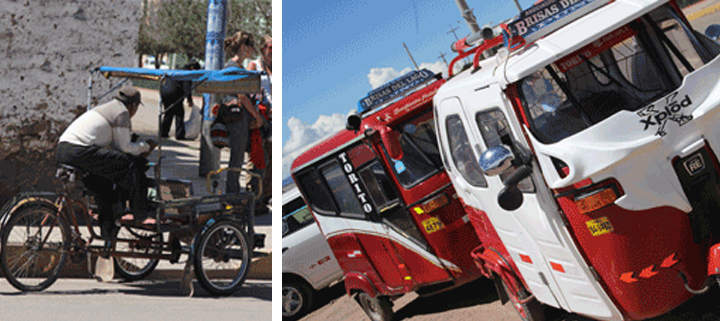
Just like everything else, time marched
on. Puno was a sprawling, bustling, crowded city and Peru's second
biggest tourist attraction. If you traveled there in style, which
I didn't, you took the $200 luxury train from Cusco to Puno.
Otherwise, you took the bus like me. And, I just couldn't believe
my eyes when we rounded the mountain pass and I saw how big Puno was.
Naturally, I wanted to see the floating islands again. These man-made islands, made by the Uros Indians, had been around for centuries. The story had is that the Uros didn't like the local Collas or Incas. Building their own islands was their solution to the problem. This time, I signed up for a tour. On the plus side of things, I had a guide who spoke English.
Naturally, I wanted to see the floating islands again. These man-made islands, made by the Uros Indians, had been around for centuries. The story had is that the Uros didn't like the local Collas or Incas. Building their own islands was their solution to the problem. This time, I signed up for a tour. On the plus side of things, I had a guide who spoke English.
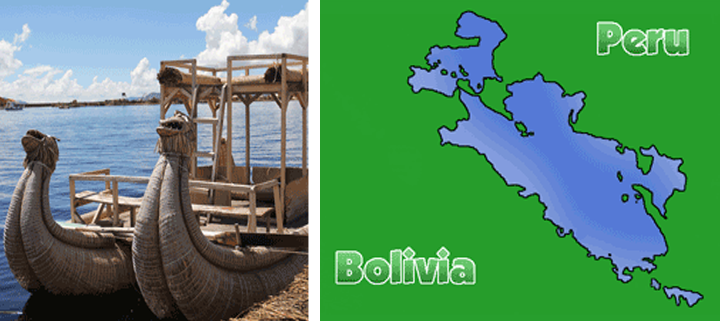
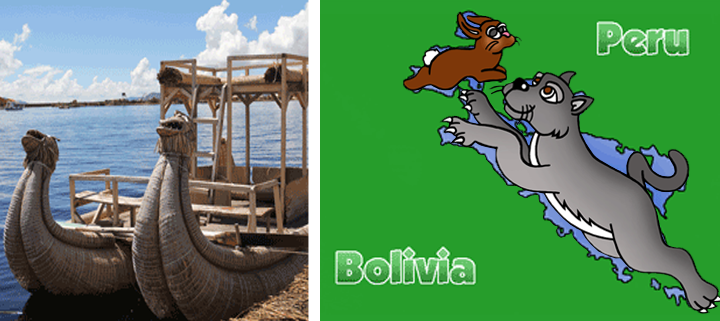
Scroll over
the upside down image of the lake to see the hare and puma.
The guide provided information about the
islands that I never had before. For starters, why did the lake
have such a funny name? Titicaca come from two words, Puma (Titi)
and Grey (caca). And, if you turn the map of the lake upside down,
and use your imagination, it sort of looks like a puma chasing a hare.
There were now 60 islands made by the Uros. Each island had a base made of totora roots that were cut from Lake TIticaca during the low season of the waters. Blocks were cut in yard cubes and placed two blocks deep. Then, harvested reeds were placed upon those blocks to build the islands. It all sounded relatively solid for floating islands. However, each island was staked into place to keep it from floating over to Bolivia, who shared about half of the lake with Peru.
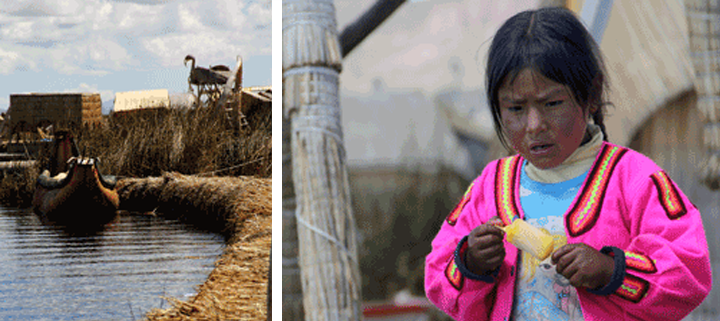
My tour visited two islands. My, oh, my! How times had changed! The Uros were set up for tourism, too. At the first island, all their handicrafts were displayed for all to see. On the second island, there was mostly a bar and restaurant. On the plus side, the islands seemed a lot sturdier this time around. When you are walking on a bunch of reeds, you aren't walking on solid ground. On my first visit, I stepped where I shouldn't have, and sank in rotting muck. No muck, no mire, no slime, no disgust on this voyage. So, not all change is bad.
Back in Puno, I grabbed my luggage and headed to the bus terminal. There was more to see around Lake Titicaca that I missed on my first trip. I wanted to get to Copacabana, Bolivia. But, at the bus station I almost changed my mind. I was shocked with the $135 visa into Bolivia only for US citizens. Apparently, the two countries were not on the best of terms. Who knew? I had to think about that visa seriously. It would probably be my last chance to ever see the Island of the Sun and the Island of the Moon. Bite the bullet and take the adventure! It was now or never to see those islands.
It was now.
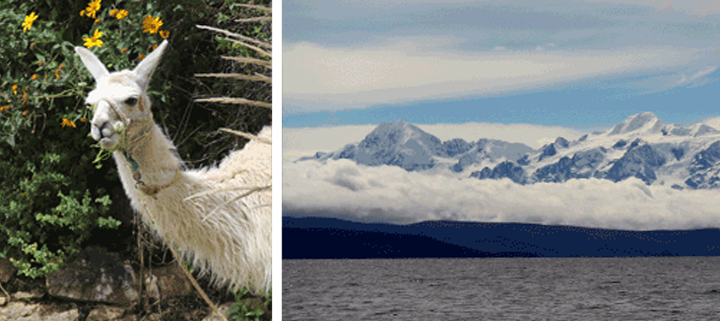
Quite opposite of Cusco and Puno, Copacabana remained a sleepy little town. It was nothing close to the hottest spot north of Havana. A sweatshirt or an alpaca wool sweater were needed most of the day. Yes, there were tourists and souvenirs, but it was nothing compared to the scale of Peru. There were cafes along the shore of the lake and Spanish music in the air. No trace (or sound) of Barry Manilow.
When you come to Copacabana, you come to see the Islands of the Sun and the Moon. In Inca folk lore, the Island of the Sun was the home of the supreme Inca god, Inti. The Island of the Moon was the home of the Inca goddess Mama Quila.
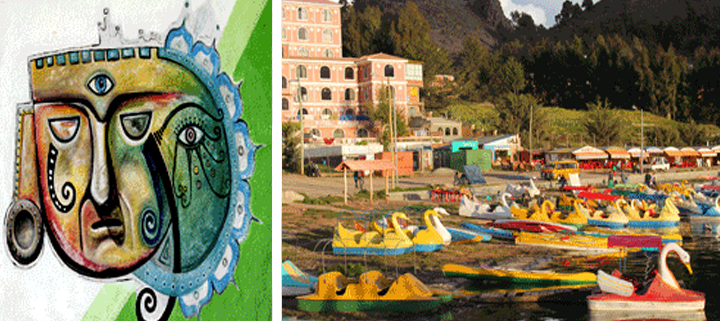
Call me a spoiled traveler if you
like. When I take a boat ride, I want two things. I want
enough life preservers for everyone and a toilet. For the first
two hours of the ride towards the Island of the Moon, I only saw four
life preservers. There was no toilet. Fortunately, there were no
emergencies requiring either of those necessities. And, much to my
relief, I did later see a stash of preservers. There still was no
toilet.
There was a temple on the Island of the
Moon. Parts were restored to let you have an idea what it looked
like originally. Parts were in ruins. It was peaceful.
Well, it was peaceful when you weren't badgered by women with the
traditional tall bowler hats and long ponytails hawking souvenirs.
The rest of the island had some adobe buildings, a smattering of llamas, gardens, and a path up to the top of the island. If you've never been in a high altitude, you have no idea what it can do to your energy supply. I just couldn't see the point in climbing to the top on an island to see the same view I just saw from the boat, just from a different angle. I went back to the temple ruins while others climbed. It was much more peaceful on the second visit and so much more satisfying.
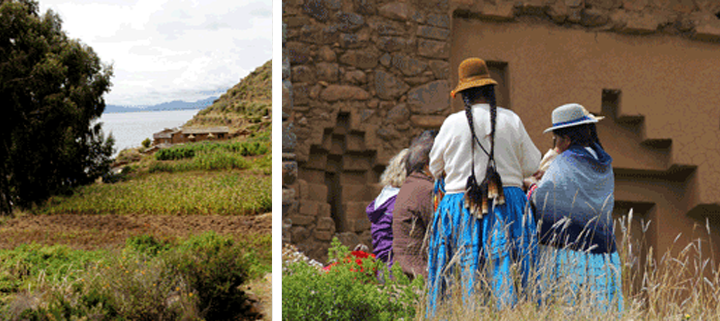
The rest of the island had some adobe buildings, a smattering of llamas, gardens, and a path up to the top of the island. If you've never been in a high altitude, you have no idea what it can do to your energy supply. I just couldn't see the point in climbing to the top on an island to see the same view I just saw from the boat, just from a different angle. I went back to the temple ruins while others climbed. It was much more peaceful on the second visit and so much more satisfying.

Island of the Moon
On to the Island of the Sun!
It's the biggest island in Lake
Titicaca. There was actually a small community that lived on the
Island of the Sun and they were set up more for visitors. There
was a temple to the sun not far from the docks, but I didn't find a path
to it. My guess is you had to climb high up the mountain to cross
over to the temple. I climbed halfway up the mountain. That
was far enough. The highlight for me was two very young girls with
two very young alpacas. They posed for photos, and they were
simply adorable.
I still think any tour should have included a stop at the Temple of the Sun. Mine didn't, others did. So, I was very pleased that we passed by the temple on the boat ride back to Copacabana. I would have been even happier if we stopped to explore. Perhaps I need to write a letter to the tourism board or Barry Manilow.
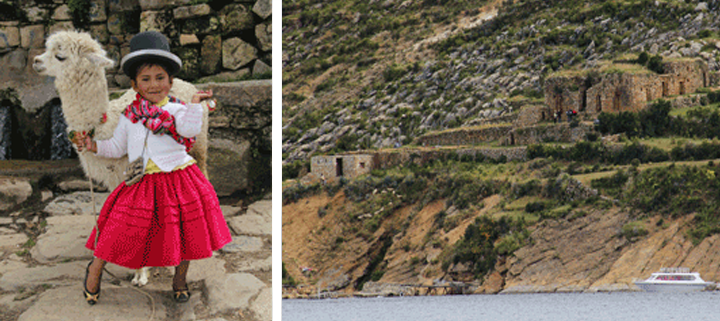
I still think any tour should have included a stop at the Temple of the Sun. Mine didn't, others did. So, I was very pleased that we passed by the temple on the boat ride back to Copacabana. I would have been even happier if we stopped to explore. Perhaps I need to write a letter to the tourism board or Barry Manilow.

Island of the Sun
